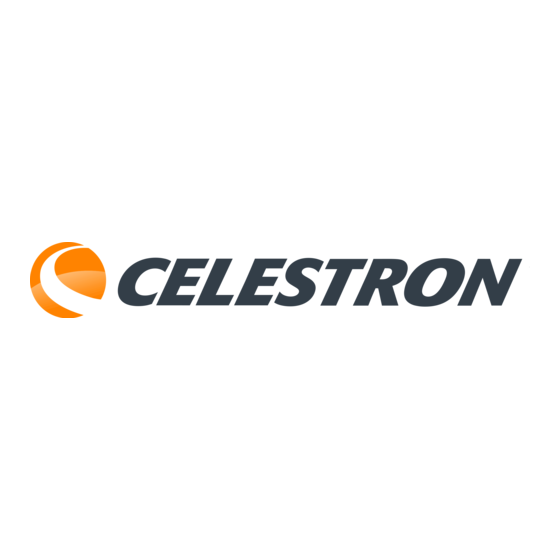Table of Contents
Advertisement
Quick Links
Advertisement
Table of Contents

Summary of Contents for Celestron SkyScout Scope 90
-
Page 2: Table Of Contents
INTRODUCTION ... 3 ASSEMBLY ... 5 Setting up the Tripod ... 5 Moving the Telescope Manually ... 6 Attaching the Telescope Tube to the Mount... 6 Installing the Diagonal & Eyepieces... 7 Aligning the Finderscope... 7 Attaching the SkyScout... 8 Aligning the SkyScout ... -
Page 3: Introduction
Congratulations on your purchase of the SkyScout Scope. The SkyScout Scope is made of the highest quality materials to ensure stability and durability. All this adds up to a telescope that gives you a lifetime of pleasure with a minimal amount of maintenance. - Page 4 Figure 1-1 SkyScout Scope 90mm Refractor Objective Lens Telescope Optical Tube SkyScout (not included) SkyScout Bracket Finderscope Eyepiece Erect Image Diagonal Focuser Pan Handle Tripod Accessory Tray Alt-Az Mount...
-
Page 5: Assembly
This section covers the assembly instructions for your SkyScout Scope. Your telescope should be set up indoor the first time so that it is easy to identify the various parts and familiarize yourself with the correct assembly procedure before attempting it outdoor. -
Page 6: Moving The Telescope Manually
Figure 2-9 The telescope optical tube attaches to the mount via a dovetail slide bar mounting bracket at the top of the mount (Figure 2-11). The mounting bar is the bracket which is attached to the tube rings. Before you attach the optical tube, make sure that the pan handle and azimuth lock are fully locked. -
Page 7: Installing The Diagonal & Eyepieces
The eyepiece (or ocular) is an optical element that magnifies the image focused by the telescope. Without the eyepiece it would be impossible to use the telescope visually. Eyepieces are commonly referred to by focal length and barrel diameter. -
Page 8: Attaching The Skyscout
1. Turn on the SkyScout so that it can get a GPS link. 2. While the SkyScout is linking, use the finder scope to point the telescope at a known bright star or planet. 3. Center the object in the 40mm eyepiece. -
Page 9: Telescope Basics
(Newtonians), use mirrors. Developed in the early 1600s, the refractor is the oldest telescope design. It derives its name from the method it uses to focus incoming light rays. The refractor uses a lens to bend or refract incoming light rays, hence the name (see Figure 3-1). -
Page 10: Determining Field Of View
This inconsistency can and will affect the ability to focus your telescope. In most cases you will not be able to achieve a truly sharp image, while in some cases, you may actually see a double image. -
Page 11: Celestial Observing
With your telescope set up, you are ready to use it for observing. This section covers visual observing hints for both solar system and deep sky objects as well as general observing conditions which will affect your ability to observe. -
Page 12: Observing Deep Sky Objects
Reduction filters help reduce the background sky brightness, thus increasing contrast. Viewing conditions affect what you can see through your telescope during an observing session. Conditions include transparency, sky illumination, and seeing. Understanding viewing conditions and the effect they have on observing will help you get the most out of your telescope. -
Page 13: Telescope Maintenance
NOT sealed, the covers should be placed over the openings when not in use. This will prevent contaminants from entering the optical tube. Internal adjustments and cleaning should be done only by the Celestron repair department. If your telescope is in need of internal cleaning, please call the factory for a return authorization number and price quote. -
Page 14: Optional Accessories
Omni Barlow Lens ( 93326)– Used with any eyepiece, it doubles the magnification of that eyepiece. A Barlow lens is a negative lens that increases the focal length of a telescope. The 2x Omni is a 1.25” barrel, is under 3” (76mm) long, and weights only 4oz. (113gr.). -
Page 15: Technical Specifications
Resolution: Rayleigh Dawes Limit Light Gathering Power Field of View: standard eyepiece Linear FOV (@1000 yds) Optical Tube Length Telescope Weight Note: Specifications are subject to change without notice or obligation 21068 90mm (3.5") refractor 660mm F/7.3 Fully coated 6x30 Erect Image Altazimuth 40mm (16.5x), 10mm (66x) - Page 16 2835 Columbia Street Torrance, CA 90503 U.S.A. Tel. (310) 328-9560 Fax. (310) 212-5835 Website www.celestron.com Copyright 2007 Celestron All rights reserved. (Products or instructions may change without notice or obligation.) Item # 21068-INST Printed in China $10.00 11-07...












Need help?
Do you have a question about the SkyScout Scope 90 and is the answer not in the manual?
Questions and answers